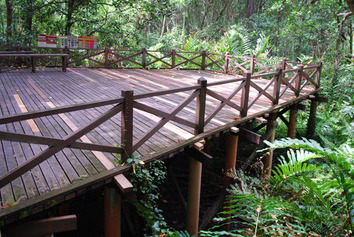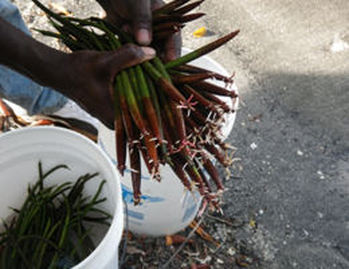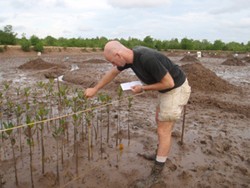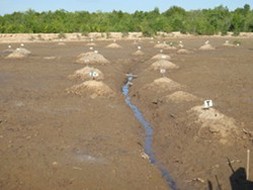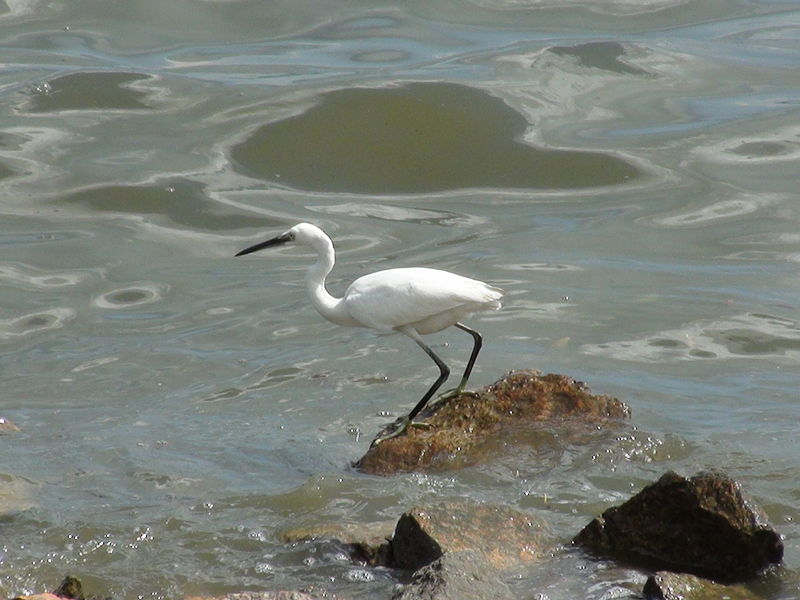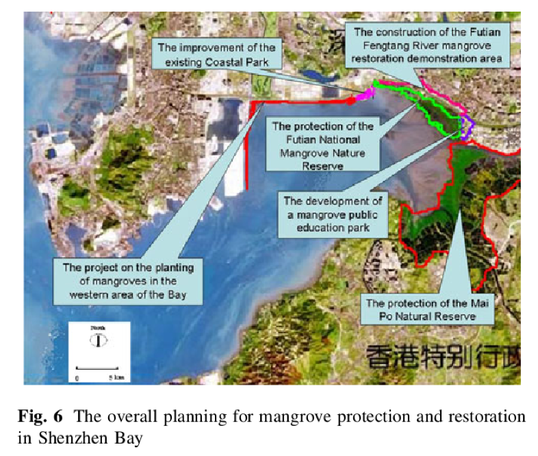The Problems
Success of planting mangroves can vary from 0 to 100%. The success is dependent on many variables such as the site, the techniques involved, and the types of plants. Two critical factors in planting of mangroves are sites with little or no waves, and the elevation within the intertidal [4]. There have been many failures in mangrove restoration [5]. Experiences in mangrove restoration has brought new insight on what needs to be facilitated when restoring mangroves. Mangroves cannot be restored in areas with wave action, cannot be submerged for more than 30% of the time, planting in high densities, possibly some protection like a net is necessary to reduce other problems, and planting of appropriate seed age will all increase the likelihood of a successful restoration [9].
There have been few successes in restoration of mangroves until recently, in the past few years. This is mostly due to the lack of knowledge of the ecosystems. Trees are managed by planting species of mangroves that are highly desired for things such as fire wood and lumber. Species such as Rhizophora apiculata are planted, but then organisms such as crabs are not present in these managed forests. Therefore this creates biological deserts where they used to be productive [1]. These management strategies have struggled because they're economically focused and not focused on the whole picture.
The Philippines had a huge failure of mangrove restoration efforts in 2008. Development and fish farming has routinely decimated these mangroves, which has wiped out nearly 75% of them on these islands. Recovery efforts were great with plantings of millions of seeds, but the understanding of the plants biology and needs was not met. The seeds were planted in areas that were not habitable for them and the majority of seeds died within a year of planting. Some of the places had a lack of nutrients, or strong winds or currents. About 44,000 hectares were planted and unsuccessful in restoration [8].
There have been few successes in restoration of mangroves until recently, in the past few years. This is mostly due to the lack of knowledge of the ecosystems. Trees are managed by planting species of mangroves that are highly desired for things such as fire wood and lumber. Species such as Rhizophora apiculata are planted, but then organisms such as crabs are not present in these managed forests. Therefore this creates biological deserts where they used to be productive [1]. These management strategies have struggled because they're economically focused and not focused on the whole picture.
The Philippines had a huge failure of mangrove restoration efforts in 2008. Development and fish farming has routinely decimated these mangroves, which has wiped out nearly 75% of them on these islands. Recovery efforts were great with plantings of millions of seeds, but the understanding of the plants biology and needs was not met. The seeds were planted in areas that were not habitable for them and the majority of seeds died within a year of planting. Some of the places had a lack of nutrients, or strong winds or currents. About 44,000 hectares were planted and unsuccessful in restoration [8].
The Successes
Malaysia
The Matang forest in Malaysia has been managed sustainably for over a century. Out of the 40,000 ha, about 2,000 ha are completely untouched and reserved, while other areas are set aside for research, education, and sanctuaries [6].
The management of the forest has been to divide the forest into 30-year rotations. The forest is then divided into blocks that are assigned to forestry departments. They then move in and clear cut that area, leaving the section closest tot he water to prevent erosion. The logs are cut and used for charcoal. This allows the clear cut areas to be surrounded by mature areas and it can propagule easily. Natural seeding can be helped via artificial planting if needed. The site are inspected for two years after the clear cutting to ensure survival of seeds. The years to follow, the stand is thinned periodically [6]. |
The Caribbean
|
Barbados and the Eastern Caribbean restoration efforts took place for red mangroves in 2010. Some 1,500 red mangrove seeds were collected and allowed to root for about 3-4 weeks. They had two kinds of propagules to use in this restoration, 1) seeds with roots but no stem or leaf development, and 2) seeds with root, stem, and leaf development. These were planted in pre-marked plantations, and they were successfully able to establish 500 healthy plants. After the established of the rooted plants, monitoring took place. Salinity and nekton are sampled for the remainder of the project. The site is continually maintained with fences to prevent erosion. They plan on continuing their efforts in collecting and planting seeds [7]. |
Thailand
Mangrove Action Project, the Wetlands International Thailand Office, and the Asia Pacific Forum collaborated in the restoration of what used to be an aquaculture pond. It was initially a mangrove forest before the pond, and was abandoned within five years of operation. Their strategies implement the encouragement of natural regeneration.
The pond floor was flushing, but was not regenerating because the pond floor was too low. So the above team drew up plans to improve the site for natural channels. This site has been beneficial in allowing for research in various techniques in digging, tools, ideas, and erosion [5]. |
Shenzhen Bay,
|
Overall Planning of Shenzhen Bay
This study concluded that the restoration and protection of the bay's mangroves should have goals that include:
With these goals in mind, the following six projects in the below figure have been planned [9].
- protect the birds and mangroves to ensure biodiversity
- protect the economic interests of fishermen
- satisfy the public's wants and needs for tourism within the mangroves and wetlands
With these goals in mind, the following six projects in the below figure have been planned [9].
